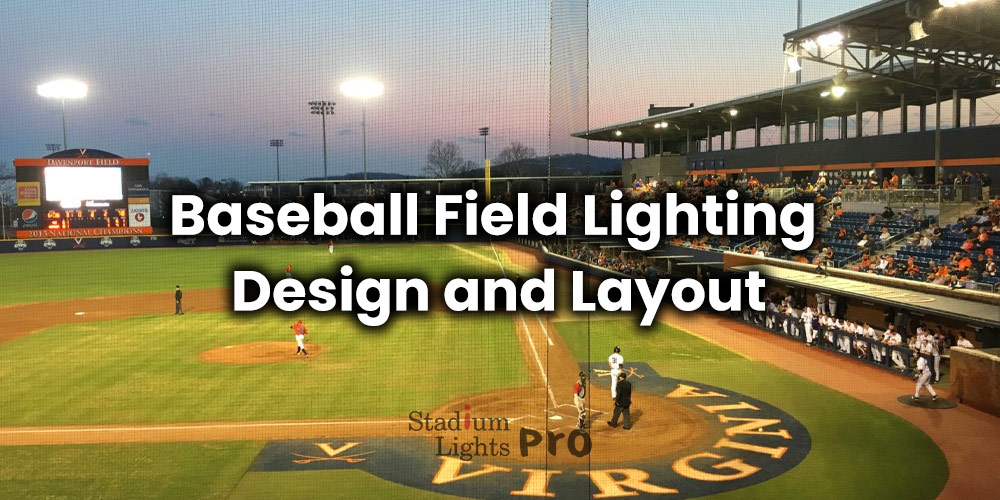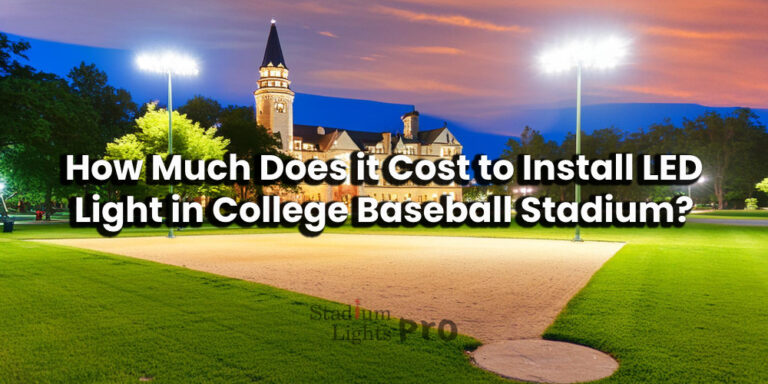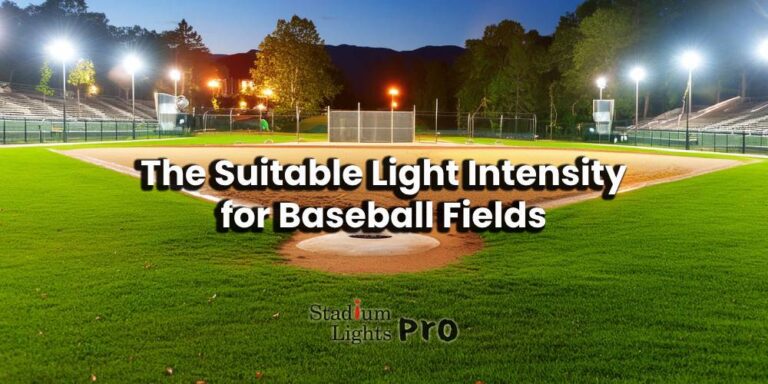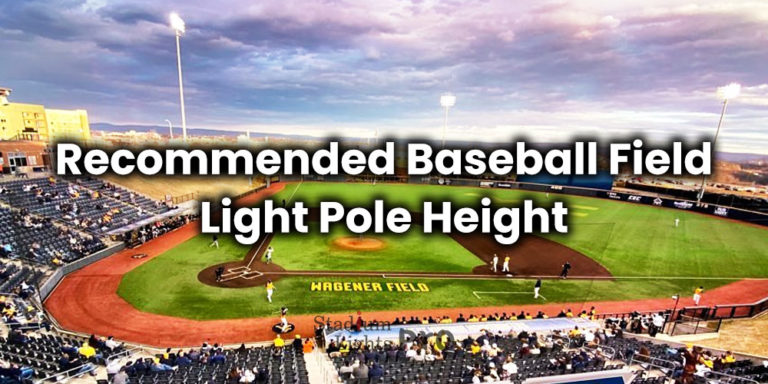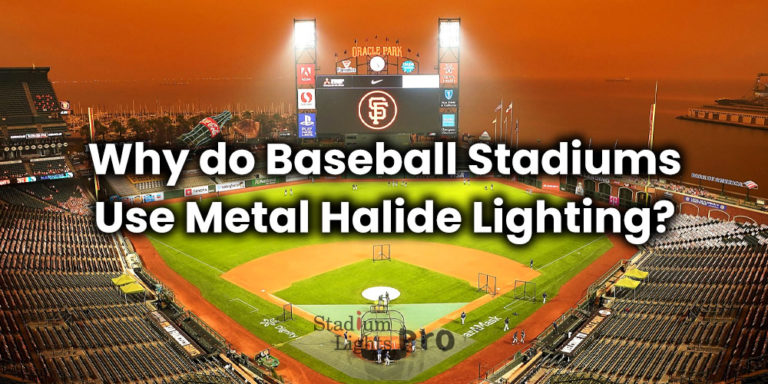Baseball field lighting design involves planning and implementing a lighting system for a baseball field that meets the necessary light levels for the game to be played safely and accurately. This involves selecting appropriate lighting equipment and determining the best placement of lighting poles and fixtures to provide sufficient illumination of the playing field, while also considering factors such as energy efficiency and cost. Proper lighting is essential in baseball, as it allows players to see the ball and make plays, and also helps to create a safe and enjoyable atmosphere for spectators.
Designing the baseball field lighting system
Light level requirements for baseball
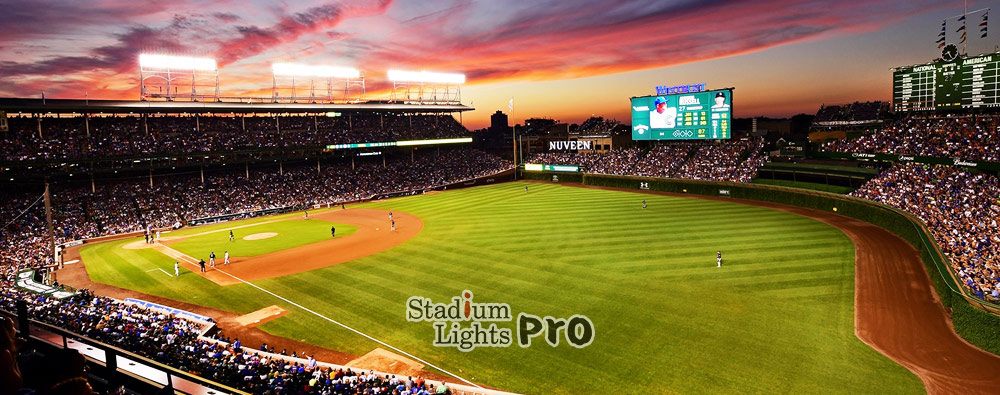
The amount of light, or illuminance, needed on a baseball field is typically measured in lux. The recommended light level for a baseball field is 500 lux. This is the minimum light level needed for the game to be played safely and accurately. However, some professional baseball stadiums may have light levels that are even higher, ranging from 750 to 1000 lux. It’s essential to note that the actual light level on the field may vary depending on factors such as the time of day, weather conditions, and the type of lighting equipment being used.
Lighting equipment options
Metal halide lights
Metal halide lamps are a type of high-intensity discharge (HID) lamp that are commonly used in outdoor lighting applications, including baseball fields. They are known for their bright, white light and relatively high efficiency compared to other HID lamp types. Metal halide lamps produce light by passing an electric current through a gas-filled arc tube, which contains a small amount of mercury vapor and various metal halides. The heat and light produced by the arc reaction excites the metal halides, which then emit light when they return to their lower energy states.
One advantage of metal halide lamps is that they can be designed to produce a wide range of color temperatures, from warm white to cool white. This allows them to be used in a variety of lighting applications, including sports lighting. However, they do have some limitations, such as a relatively short lifespan compared to other types of lighting technologies, and a warm-up period during which they may not reach their full brightness.
LED baseball field lighting fixtures
LED (light-emitting diode) lights are a type of solid-state lighting that are highly efficient and long-lasting. They are becoming increasingly popular for outdoor lighting applications, including sports lighting, due to their energy efficiency, durability, and ability to produce high-quality light.
LED lights work by using a semiconductor material to convert electricity into light. When an electric current passes through the semiconductor, it causes electrons to move, and as they move, they emit photons (particles of light). The color of the light produced by an LED depends on the semiconductor material used.
LED lights have several advantages that make them well-suited for use in sports lighting applications. One major advantage is their energy efficiency, as they use less electricity to produce the same amount of light as other types of lighting technologies. This can lead to cost savings and reduced energy consumption. LED baseball field lights are also very durable, with a long lifespan compared to other types of lighting. Besides, they are able to produce high-quality light, with a wide color spectrum and excellent color rendering.
HID lights
High-pressure sodium (HPS) lamps are another type of high-intensity discharge (HID) lamp that are commonly used in outdoor lighting applications. They are known for their high efficiency and relatively low cost, but they are not as bright or as energy efficient as metal halide lamps or LED lights. HPS lamps produce light by passing an electric current through a gas-filled arc tube, which contains a small amount of mercury vapor and sodium. The heat and light produced by the arc reaction excites the sodium, which then emits light when it returns to its lower energy states. HPS lamps produce a warm, yellowish light, which can make colors appear less vibrant.
Fluorescent lamps
They are a type of low-pressure discharge lamp that use a gas-filled tube to produce light. They work by passing an electric current through the gas, which causes it to emit ultraviolet (UV) radiation. The UV radiation then strikes a fluorescent coating on the inside of the tube, which absorbs the energy and re-emits it as visible light. Fluorescent lamps are known for their energy efficiency and long lifespan, but they may not be as bright or as durable as other types of lighting technologies. They also require a ballast to regulate the current flowing through the lamp, which can add complexity and cost. Fluorescent lamps are typically used in indoor lighting applications, but they can also be used outdoors in some cases.
Placement of baseball field lighting poles and fixtures
Height and spacing of poles
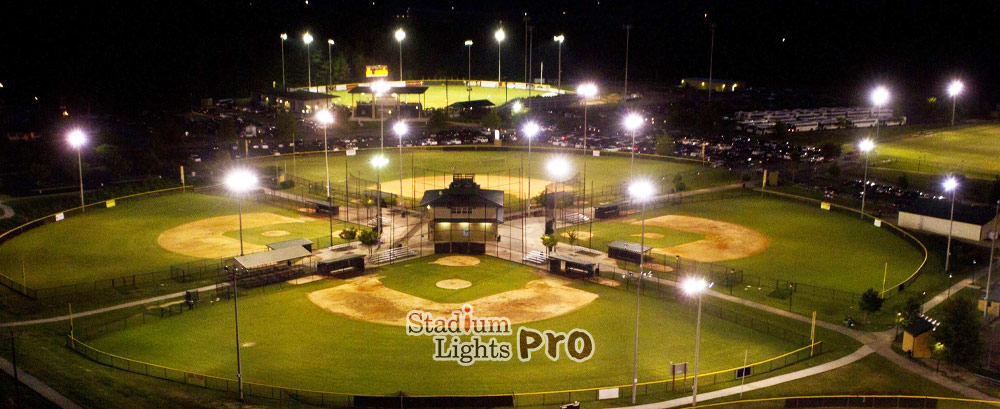
The height and spacing of lighting poles on a baseball field are crucial considerations when designing and laying out a lighting system. The height of the poles should be sufficient to provide adequate illumination of the playing field, while also minimizing shadows and glare. The spacing of the poles should be such that the light fixtures on each pole provide an even distribution of light across the field.
The height of lighting poles for a baseball field should be between 40 and 80 feet, depending on the size of the field and the light level requirements. For example, a smaller field with lower light level requirements may be able to use shorter poles, while a larger field with higher light level requirements may require taller poles. The spacing of the poles should be determined based on the size and layout of the field, as well as the height and spacing of the fixtures on the poles.
Orientation of fixtures
The baseball field lighting fixtures should be aimed in a way that minimizes shadows and glare on the field, and provides an even distribution of light.
There are several factors to consider when determining the orientation of fixtures on a baseball field lighting system. These include the height and spacing of the poles, the height and spacing of the fixtures on the poles, and the layout of the field. The orientation of the fixtures should be carefully planned to ensure that the desired light levels are achieved across the entire field, and to minimize shadows and glare that could interfere with the game.
The fixtures should be aimed so that they are slightly above the playing field, to help reduce shadows and provide even illumination. The exact orientation of the fixtures will depend on the specific characteristics of the field and the lighting system being used. Careful planning and testing will be necessary to determine the optimal orientation of the fixtures.
Color temperature of baseball field lights
The color temperature of a light source refers to the perceived warmth or coolness of the light. It is typically measured in degrees Kelvin (K) and is defined by the spectrum of visible light that the source produces. A light source with a lower color temperature (e.g. 2,700 K) appears warmer and more yellowish, while a light source with a higher color temperature (e.g. 6,500 K) appears cooler and more bluish.
The color temperature of baseball field lights should be chosen based on the desired visual appearance of the field and the players. Some sports lighting designers and players prefer a cooler, bluish light (e.g. 6,500 K) because it can make the ball and the players’ uniforms appear more vibrant and distinct. Others may prefer a warmer, yellowish light (e.g. 3,000 K) because it can create a more natural, relaxed atmosphere. Ultimately, the choice of color temperature will depend on personal preference and the specific needs of the field and players.
It’s crucial to note that the color temperature of a light source can affect how people perceive the light and their surroundings. For example, a light source with a high color temperature (e.g. 6,500 K) may be perceived as being more “clinical” or “sterile,” while a light source with a lower color temperature (e.g. 2,700 K) may be perceived as being more “warm” or “inviting.” These perceptions can be influenced by a variety of factors, including the specific color temperature of the light source and the context in which it is used.
Beam angle of the lighting fixtures
The beam angle of a light fixture refers to the angle at which the light is distributed from the fixture. It is typically measured in degrees and can affect the distribution of light across the field, as well as the appearance of the fixture itself.
In the case of baseball field lighting, the beam angle of the fixtures can be a critical consideration. A wider beam angle (e.g. 120 degrees) will result in a broader distribution of light across the field, which can be beneficial in providing more uniform illumination and reducing shadows. A narrower beam angle (e.g. 60 degrees) will result in a more focused beam of light, which can be useful for highlighting specific areas of the field or creating more directional lighting effects.
The beam angle of the fixtures should be chosen based on the specific needs of the field and the desired lighting effects. We need to consider the beam angle of the fixtures in conjunction with other factors, such as the size and layout of the field, the height and spacing of the fixtures, and the light level requirements.
Considerations for energy efficiency and cost
Energy-efficient lighting equipment options
There are several energy-efficient lighting equipment options that can be used for baseball field lighting. These options can help to reduce energy consumption and costs, while still providing the necessary light levels for the game to be played safely and accurately.
One energy-efficient option is LED lighting. LED lights are highly energy efficient, using less electricity to produce the same amount of light as other types of lighting technologies. They are also long-lasting, with a lifespan that is several times longer than other types of lighting. LED lights are able to produce high-quality light, with a wide color spectrum and excellent color rendering, making them well-suited for sports lighting applications.
Another energy-efficient option is metal halide lighting. Metal halide lamps are a type of high-intensity discharge (HID) lamp that are relatively energy efficient compared to other HID lamp types. They produce bright, white light and can be designed to produce a wide range of color temperatures, from warm white to cool white. While they may not be as energy efficient as LED lights, they can still be a more energy-efficient option compared to other types of lighting technologies.
Other energy-efficient options include high-pressure sodium (HPS) lamps and fluorescent lamps. HPS lamps are a type of HID lamp that are known for their high efficiency and relatively low cost, although they may not be as bright or as energy efficient as metal halide lamps or LED lights. Fluorescent lamps are a type of low-pressure discharge lamp that are known for their energy efficiency and long lifespan, although they may not be as bright or as durable as other types of lighting technologies.
Potential cost savings from using LED fixtures
Using LED fixtures for baseball field lighting can potentially result in cost savings in a few different ways. One way is through energy cost savings. LED lights are highly energy efficient, meaning they use less electricity to produce the same amount of light as other types of lighting technologies. This can lead to significant energy cost savings, particularly over the long term.
To illustrate this point, let’s consider a hypothetical example. Assume that a baseball field has a lighting system with 100 metal halide lamps that are used for an average of 3 hours per day, 7 days per week, for a total of 21 hours per week. Let’s further assume that the cost of electricity is $0.10 per kilowatt-hour (kWh) and that each metal halide lamp has a power rating of 1,000 watts (W). The total energy consumption of the lighting system would be 21 hours per week x 100 lamps x 1,000 W/lamp = 2,100,000 W-hours per week = 2,100 kWh per week. At a cost of $0.10 per kWh, the energy cost of the lighting system would be 2,100 kWh/week x $0.10/kWh = $210 per week, or $10,920 per year.
Now, let’s consider the same lighting system, but with LED fixtures instead of metal halide lamps. Assume that the LED fixtures have a power rating of 500 W each and are equally efficient as the metal halide lamps in terms of light output. The total energy consumption of the LED lighting system would be 21 hours per week x 100 fixtures x 500 W/fixture = 1,050,000 W-hours per week = 1,050 kWh per week. At a cost of $0.10 per kWh, the energy cost of the LED lighting system would be 1,050 kWh/week x $0.10/kWh = $105 per week, or $5,460 per year.
In this example, replacing the metal halide lamps with LED fixtures would result in energy cost savings of $5,460 per year – $10,920 per year = $5,460 per year.
LED fixtures may also result in cost savings due to their longer lifespan compared to other types of lighting. LED lights have a lifespan that is several times longer than other types of lighting, meaning they may need to be replaced less often. This can result in reduced maintenance and replacement costs over the long term.
The actual cost savings from using LED fixtures will depend on a variety of factors, including the specific lighting equipment being used, the cost of electricity, the amount of use the lighting system receives, and the maintenance and replacement costs of the fixtures. These values can vary widely and should be carefully considered when evaluating the potential cost savings from using LED fixtures.
Laying out the baseball field lighting system
Field dimensions and layout
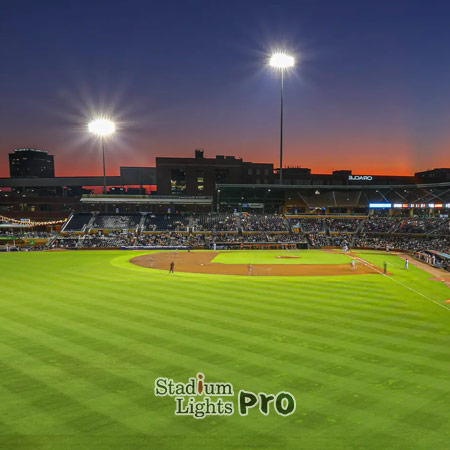 The size of the field, as well as the location and orientation of the diamond (the area where the bases are located), will affect the light levels needed to adequately illuminate the field and allow the game to be played safely and accurately.
The size of the field, as well as the location and orientation of the diamond (the area where the bases are located), will affect the light levels needed to adequately illuminate the field and allow the game to be played safely and accurately.
A baseball field is rectangular in shape, with a length of about 325 feet and a width of about 400 feet. The diamond is located in the center of the field, with the home plate at one end and the three bases (first, second, and third) arranged in a triangle at the other end. The pitcher’s mound is located about 60 feet, 6 inches from home plate, and the foul lines extend from home plate to the left and right field fences, which are typically about 300 feet from home plate.
The layout and dimensions of the field can influence the placement and orientation of the lighting poles and fixtures. For example, the location of the foul lines and the height of the fences may affect the height and spacing of the poles, as well as the orientation of the fixtures. The size and layout of the field may also influence the light levels needed to adequately illuminate the field, as larger fields with higher light level requirements may require taller poles and more fixtures.
Placement of baseball diamond lighting poles and fixtures
The placement of lighting poles and fixtures on a baseball field is a critical consideration when designing and laying out a lighting system. The poles and fixtures should be placed in a way that provides adequate illumination of the playing field, while also minimizing shadows and glare.
There are several factors to consider when determining the placement of lighting poles and fixtures on a baseball field. These include the size and layout of the field, the height and spacing of the poles and fixtures, and the orientation of the fixtures.
The poles should be spaced evenly around the perimeter of the field, with the fixtures mounted on top of the poles. The spacing of the poles should be determined based on the size and layout of the field, as well as the height and spacing of the fixtures on the poles. The orientation of the fixtures should be carefully planned to ensure that the desired light levels are achieved across the entire field, and to minimize shadows and glare that could interfere with the game.
How many baseball field light poles do I need?
The number of lighting poles needed for a baseball field will depend on a variety of factors, including the size of the field, the light level requirements, and the desired distribution of light across the field. To determine the number of poles needed, you will need to make some assumptions about the specifics of the field and the lighting system being used. Here is an example of how you might calculate the number of poles needed based on certain assumptions:
Assumptions:
- Field size: 325 feet x 400 feet
- Light level requirement: 30 fc
- Fixture power: 1,000 watts
- Pole height: 50 feet
- Fixture spacing on pole: 10 feet
To calculate the number of poles needed, we first need to determine the total light output of the fixtures. This can be calculated by multiplying the fixture power by the number of fixtures on each pole. In this case, with 1,000 watt fixtures spaced 10 feet apart on a 50-foot pole, we would have 5 fixtures per pole. The total light output of the fixtures would therefore be 5 fixtures x 1,000 watts/fixture = 5,000 watts.
Next, we need to determine the spacing between the poles. To achieve a light level of 30 fc at a distance of 50 feet (the height of the poles), we can use the following formula:
- Spacing = (Pole height x desired light level) / (Fixture output x coefficient of utilization)
To cover the entire field with the lighting system, we can calculate the number of poles needed by dividing the length of the field by the spacing between the poles. In this case, the number of poles needed would be calculated as follows:
- Number of poles = Field length / Pole spacing
- Number of poles = 325 feet / 71.4 feet
- Number of poles = 4.5 poles
Since we can’t have half a pole, we would round up to 5 to 6 poles.
This is just one example of how the number of poles might be calculated, and the actual number of poles needed may vary depending on the specific characteristics of the field and the lighting system being used. Careful planning and testing will be necessary to determine the optimal number of poles needed to meet the needs of the field and the players.
Cable and electrical considerations
There are several cable and electrical considerations to keep in mind when designing and installing a baseball field lighting system. These include the type and size of the cables, the location and placement of electrical boxes, and the electrical load on the system.
The type and size of the cables used in the lighting system will depend on the distance between the poles and fixtures, the power requirements of the fixtures, and any local codes and regulations that must be followed. In general, larger cables will be required for longer distances and higher power loads, while smaller cables may be sufficient for shorter distances and lower power loads.
The location and placement of electrical boxes, such as junction boxes and distribution boxes, will depend on the layout of the field and the lighting system. These boxes should be located in a convenient and accessible location, and should be properly sized to accommodate the cables and electrical components of the system.
It’s also essential to consider the electrical load on the lighting system, which is the total amount of electricity required to power the fixtures. The electrical load should be carefully calculated to ensure that the system is properly sized and that it can be safely powered by the available electrical supply. Any necessary electrical upgrades or modifications should be made as needed to support the lighting system.
Testing and fine-tuning the sports lighting system
After installing a sports lighting system, we may test and fine-tune the system to ensure that it is operating properly and meeting the needs of the players and spectators. This can involve a variety of tasks, including checking the light levels and distribution, adjusting the orientation of the fixtures, and troubleshooting any problems that may arise.
To test and fine-tune the sports lighting system, it may be necessary to take a series of light readings using a light meter or other measurement device. These readings can be taken at various locations around the field to determine the light levels and distribution, and to identify any areas that may be under- or over-illuminated. Based on these readings, the orientation of the fixtures may need to be adjusted to improve the distribution of light across the field.
Conclusion
The design and layout of a baseball field lighting system involves a number of considerations, including the size and layout of the field, the light level requirements, the type and placement of the fixtures, and the cable and electrical components of the system. Careful planning and testing will be necessary to determine the optimal design and layout of the lighting system, and to ensure that it meets the needs of the players and spectators.
If you’re considering upgrading or installing a new baseball field lighting system, we would be happy to help you with the design and layout process. We offer free consultations to help you determine the best lighting solution for your field. Our team of experienced lighting designers can work with you to assess your needs and develop a customized lighting plan that meets your specific requirements.
With our expertise and knowledge of the latest lighting technologies, we can help you create a lighting system that provides the necessary light levels and quality for the players and spectators, and that is efficient, reliable, and cost-effective. We can also provide assistance with the installation and maintenance of the lighting system to ensure that it is operating safely and effectively.
If you’re interested in learning more about our baseball field lighting design and layout services, please don’t hesitate to contact us. We would be happy to discuss your needs and provide a free consultation to help you get started.

